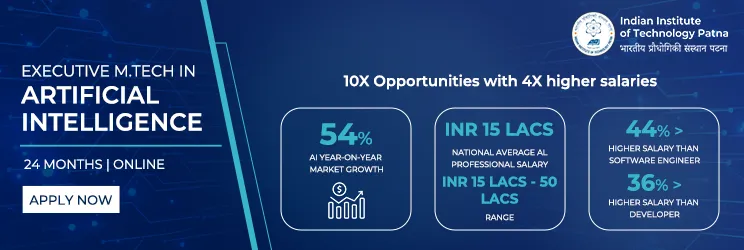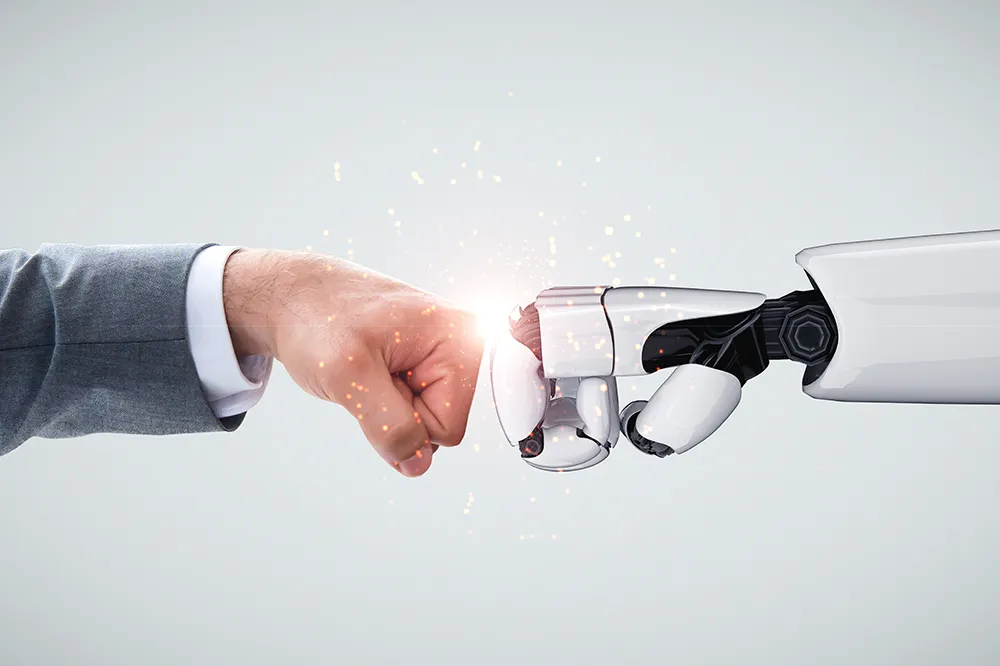Companies across India are automating their data collection, analysis, and visualisation processes. They are also consciously incorporating artificial intelligence in their business plans to reduce human effort and stay ahead of the curve. Machine learning, a subset of artificial intelligence, has become one of India’s most in-demand career paths. It is a method of data analysis that is being used by experts to automate analytical model building. Moreover, systems are continuously evolving and learning from data, identifying patterns, and providing valuable insights with minimal human intervention, thanks to machine learning. Now that we know why this path is in demand, let us learn more about the types of machine learning.
Types of Machine Learning
The four different types of machine learning are:

- Supervised Learning
- Unsupervised Learning
- Semi-Supervised Learning
- Reinforced Learning
1. Supervised Learning
In this type of machine learning, machines are trained using labelled datasets. Machines use this information to predict output in the future. This whole process is based on supervision and hence, the name. As some inputs are mapped to the output, the labelled data helps set a strategic path for machines. Moreover, test datasets are continuously provided after the training to check if the analysis is accurate. The core objective of super learning techniques is to map the input variables with the output variables. It is extensively used in fraud detection, risk assessment, and spam filtering.

Let’s understand supervised learning with an example. Suppose we have an input dataset of cupcakes. So, first, we will provide the training to the machine to understand the images, such as the shape and portion size of the food item, the shape of the dish when served, ingredients, colour, accompaniments, etc. After completion of training, we input the picture of a cupcake and ask the machine to identify the object and predict the output. Now, the machine is well trained, so it will check all the features of the object, such as height, shape, colour, toppings, and appearance, and find that it’s a cupcake. So, it will put it in the desserts category. This is the process of how the machine identifies various objects in supervised learning.
Supervised machine learning can be classified into two types of problems:
Classification
When the output variable is a binary and/or categorical response, classification algorithms are used to solve the problems. Answers could be – Available or Unavailable, Yes or No, Pink or Blue, etc. These categories are already present in the dataset and the data is classified based on the labelled sets provided during training. This is used across India in spam detection.
Regression
Unlike classification, a regression algorithm is used to solve problems where there is a linear relationship between the input and output variables. Regression is used to make predictions like weather, and market conditions.
Here are the Five Common Applications of Supervised Learning:
- Image classification and segmentation
- Disease identification and medical diagnosis
- Fraud detection
- Spam detection
- Speech recognition
Also Read: Top 10 Machine Learning Jobs in India: A Look at the Opportunities Obtainable
2. Unsupervised Learning
Unlike the supervised learning technique, here there is no supervision involved. Unlabeled and unclassified datasets are used to train the machines. They then predict the output without supervision or human intervention. This method is commonly used to bucket or categorise unsorted data based on their features, similarities, and differences. Machines are also capable of finding hidden patterns and trends from the input.
Let us look at an example to understand better. A machine might be provided with a mixed bag of sports equipment as input. Though the image is new and completely unknown, using its learning model the machine tries to find patterns. This could be colour, shape, appearance, size, etc to predict the output. Then it categorises the objects in the image. All this happens without any supervision.
Unsupervised learning can be classified into two types:
Clustering
In this technique, machines bucket the data based on the features, similarities, and differences. Moreover, machines find inherent groups within complex data and ensure object classification. This is commonly used to understand customer segments and purchasing behaviour, especially across geographies.
Association
In this learning technique machines find interesting relations and connections among variables within large datasets that are provided as input. How is one data item dependent on another? What is the procedure to map variables? How can these connections result in profit? These are the main considerations in this learning technique. This algorithm is especially popular in web usage mining and plagiarism checking in doctoral work.
Four Common Applications of Unsupervised Learning
- Network analysis
- Plagiarism and copyright check
- Recommendations on e-commerce websites
- Detect fraud in bank transactions
3. Semi-Supervised Learning
This technique was created keeping the pros and cons of the supervised and unsupervised learning methods in mind. During the training period, a combination of labelled and unlabeled data sets is used to prepare the machines. However, in the real world, most input datasets are unlabeled data. This method’s advantage is that it uses all available data, not only labelled information so it is highly cost-effective. Firstly, similar data is bucketed. This is done with the help of an unsupervised learning algorithm. This helps label all the unlabeled data.
Let us take the example of a dancer. When the dancer practices without any trainer’s support it is unsupervised learning. In the classroom, however, every step is checked and the trainer monitors progress. This is supervised learning. Under semi-supervised learning, the dancer has to follow a good mix. They need to practise on their own but also need to revisit old steps in front of the trainer in class.
Semi-supervised learning falls under hybrid learning. Two other important learning methods are:
Self-Supervised learning
An unsupervised learning problem is framed as a supervised problem in order to apply supervised learning algorithms to solve it.
Multi-Instance learning
It is a supervised learning problem but individual examples are unlabeled. Instead, clusters or groups of data are labelled.
Also Read: Machine Learning Trends 2023
4. Reinforcement Learning

In reinforcement learning, there is no concept of labelled data. Machines learn only from experiences. Using a trial and error method, learning works on a feedback-based process. The AI explores the data, notes features, learns from prior experience and improves its overall performance. So, the AI agent gets rewarded when the output is accurate. And punished when the results are not favourable.
Let us understand this better with an example. If a corporate employee has been given a completely new project then their success will be measured based on the positive results at the end of the stint. In fact, they receive feedback from superiors in the form of rewards or punishments. The office is the environment, and the employee carefully takes the next steps to successfully complete the project. Reinforcement learning is widely popular in game theory and multi-agent systems. This method is also formalised using the Markov Decision Process (MDP). Using MDP, the AI interacts with the environment when the process is ongoing. After each action, there is a response and it generates a new state.
Reinforcement Learning can be Categorised into Two Methods:
- Positive Reinforcement Learning
- Negative Reinforcement Learning
How is Reinforcement Training Used in the Real World?
- Building intelligent robots
- Video games and interactive content
- Learn and schedule resources
- Text Mining
Real-World Application of Machine Learning
Machine learning is booming! The AI market in India was valued at Rs. 472.73 billion in 2020. By 2027, it is anticipated to reach Rs. 2113.60 billion, thereby expanding at a CAGR of 24.17% from 2021 to 2027. Therefore, with its immense potential to transform businesses across India, machine learning is being adopted at a swift pace. Moreover, thousands of new jobs are cropping up and the skills are in high demand.
Here are a Few Real-World Applications of Machine Learning:
- Medical diagnosis
- Stock market trends and predictions
- Online fraud detection
- Language translation
- Image and speech recognition
- Virtual smart assistants like Siri and Alexa
- Email filtering especially spam or malware detection
- Traffic prediction on Google maps
- Product recommendations on e-commerce sites like Amazon
- Self-driving cars like Tesla
Benefits of Machine Learning in India
Machine learning is undoubtedly an emerging field, predominantly in artificial intelligence technology. So, several companies across India are deliberately adopting this technology to progress across various industries. So, some of them include airlines, investment, finances, retail, etc.
Here, we have listed some of the compelling benefits of machine learning:
- The algorithms are capable of recognising images and classifying them into various categories.
- Natural language processing enables machine learning algorithms to process language-based inputs from humans through an organisation’s website.
- Machine learning enables autonomous vehicles to learn safe navigation across the real world.
- It paves the way for data mining, i.e., assessing data and finding patterns within the same.
- It has the potential to handle extremely large amounts of data, using customer segmentation processes for improving marketing.
- The machine learning algorithms can predict consumers who are very likely to purchase an actual product.
- Fraud detection is immensely crucial across various organisations. So machine learning algorithms are capable of analysing behaviour and spending patterns, thereby identifying potential instances of fraud.
- It can provide aid speech recognition applications for interpreting voice-based inputs from consumers. Besides, it can also be useful for dictation software, enabling people to take notes without writing or typing.
- Machine learning algorithms can efficiently analyse combinations and patterns of lifestyle factors, symptoms, and medical histories.
- It has the potential to make accurate predictions and evaluate possible outcomes.
Every user today generates nearly 2 Mbps of data. In this data-driven world, it is increasingly important for businesses to digitally transform and keep up. By analysing and visualising data better, companies can have a good competitive advantage. In order to stay ahead, companies are constantly looking for top talent to bring their vision to life.
Conclusion
If you are looking for online courses that can help you pick up the necessary machine-learning skills, then look no further. Click here to explore all AI & ML courses being offered by India’s best universities in association with Emeritus. Therefore, learn to process data, build intelligent machines, make more accurate predictions, and deliver strong and innovative business value. Happy learning!